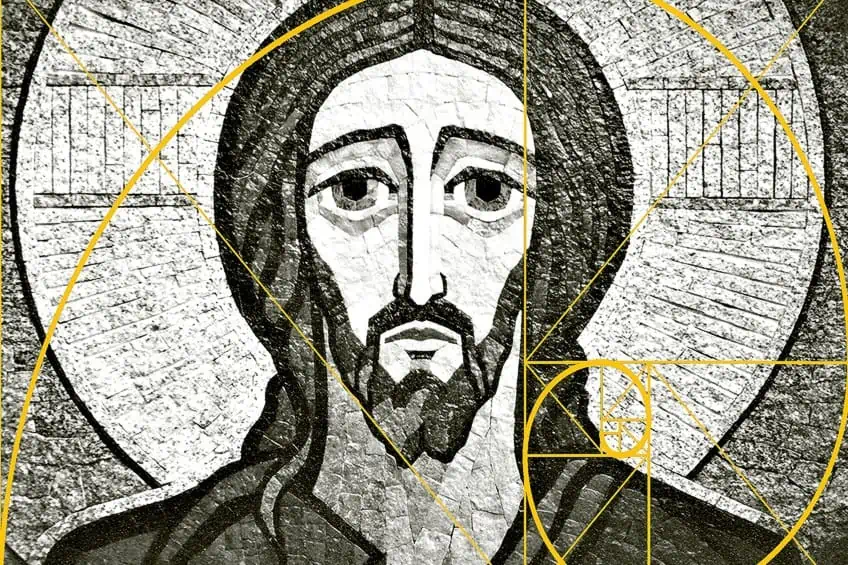Fibonacci Sequence in Art – Using the Fibonacci Spiral in Art
If you have never heard of the Fibonacci theory before, then you might have several questions regarding the matter of the Fibonacci sequence in art, for example, what is the Fibonacci sequence used for, and why is the Fibonacci sequence so important in the first place? This article will focus on the artistic implementation of the Fibonacci spiral by examining various examples of the Fibonacci sequence in art. Is the Fibonacci theory purely a mathematical concept, or does it have aesthetic value?
Exploring the Fibonacci Sequence in Art
Fibonacci was a mathematician from Italy who lived and worked in the late 11th and early 12th centuries and is credited for introducing the Arabic numeric system to Europe as well as the usage of the digit zero and decimal places.
His name is most known for the Fibonacci series, a mathematical sequence in which each number equals the sum of the two numbers before it: 1, 1, 2, 3, 5, 8, 13, 21, 34. (and so on).
Although it may not appear to be clear, there is a strong link between this sequence of numbers and artwork composition. The Fibonacci Spiral may be created by seeing each number as a square (growing in size with the sequence) and connecting the opposing corners of each square.
Why Is the Fibonacci Sequence So Important to the World?
The Fibonacci Sequence is inextricably linked to another mathematical concept, the Golden Ratio, sometimes known as the Divine Ratio. Mathematicians discovered it in abundance in nature, in locations as different as human face proportions, artichokes blossoming, and the genealogy of bees.
The Fibonacci spiral was recognized by artists as an illustration of an artistically beautiful concept – the Rule of Thirds.
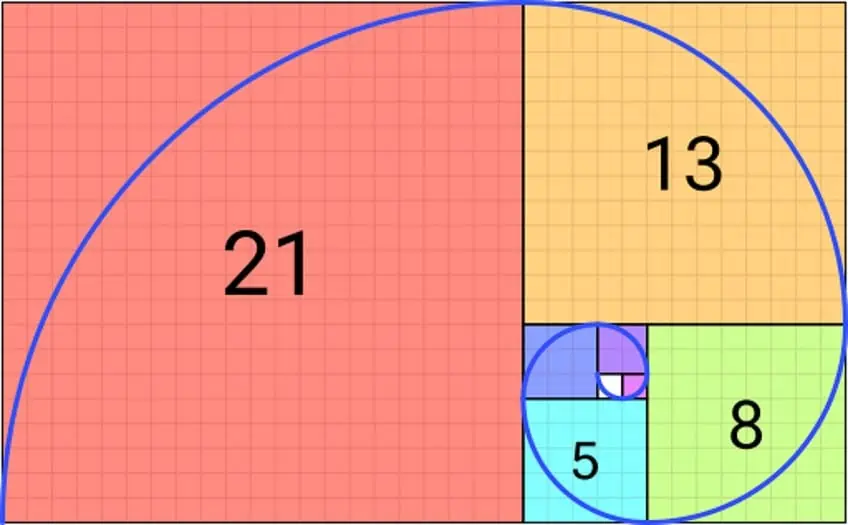
This is utilized in picture composition; by distributing the image’s components in thirds rather than precisely centering them, a more attractive flow is obtained. Since the Renaissance, painters have created dramatic and appealing paintings that display the Fibonacci spiral in their composition, whether by intention or by chance.
Exactly What Is the Fibonacci Sequence Used for in Art?
It didn’t take long for painters, particularly those well-versed in the multidisciplinary approach that traditional and Renaissance art represented at the time, to see that this idea, as appealing as it is in all other elements of life, should also be reflected in their paintings.
Adopting this notion with zeal, it became fashionable for artists of the time to include it in their creative renditions and thoughts of the day.
During this era, incorporation was purposeful, but through de facto artistic evolution, the sequencing and ratios started to infuse themselves into the artistic method of those who followed and has become an almost essential component of the artistic arrangement, both in realistic and non-figurative paintings. As a result, the Fibonacci spiral and Golden Ratio, as seen centuries ago, are today as visible in art and our perception of them as they are in nature.
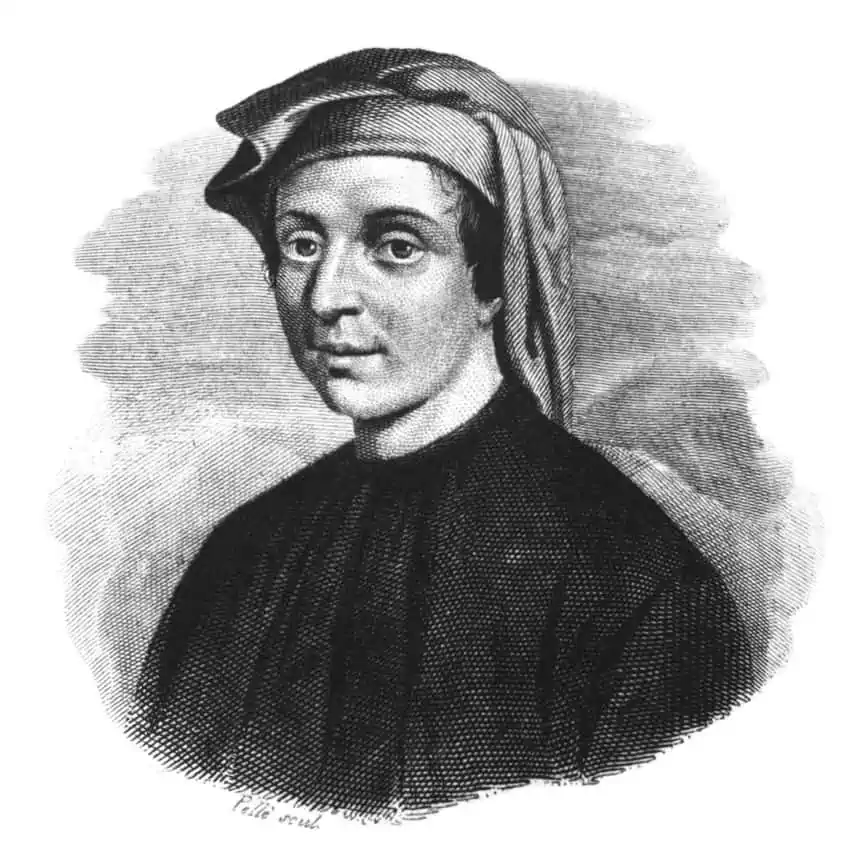
What is special about the sequence is that many artists will intentionally use its aesthetic benefits, while other highly respected photographic artworks may discover – totally by chance – that it can be reproduced onto their artwork, so much so that it has even been spotted in war photos. When it comes to establishing an aesthetic or a design new for a project, there are no restrictions for designers.
Sometimes we discover that the Golden Ratio works well in practice, while in other instances we come up with a brilliant concept that deviates from the guidelines.
The Golden Ratio in connection to design is a source of contention among mathematicians, graphic designers, and scientists. But there is ample proof, both in nature and in produced design, that a ratio is a reliable tool for creators. It can be used for constructing a grid for a layout, determining the best cropping for a photo, or determining sizes for type hierarchy when highlighting material, to mention a few examples. Overall, we believe it’s an intriguing approach to look at excellent design via a mathematical lens, and it’s amazing to see where and how it’s employed in the environment around us.
The Fibonacci Theory and Architecture
The Fibonacci spiral may be seen in the structures of significant architectural sites all across the world. The Parthenon in Greece is perhaps the most famous example. It is even supposed to have been used in the proportions of the Giza Pyramids.
The artists of Antiquity examined this proportion supplied by the number and used it in their buildings and creative works since it was thought to be inherently appealing to the human eye.
As a result, it can be verified in several architectural works, including the Parthenon, where the height and width of the exterior abide by the Golden Ratio; the Egyptian pyramids, where every single block is 1.618 times bigger than the block on the tier directly above, and a few of them have inner chambers that are 1,618 times as long as they are broad; and even the Taj Mahal, where some scholars link its configuration to the Golden Ratio.
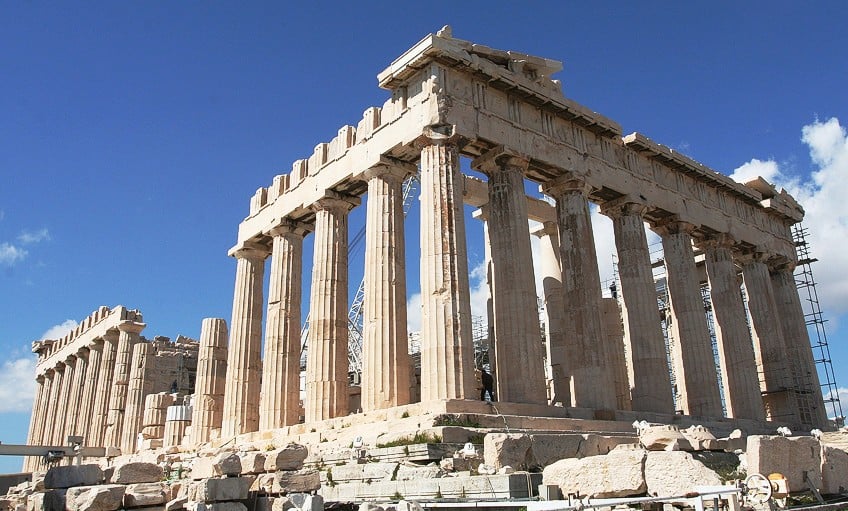
These proportional ratios offer numerous potential observations of how the magnitude of architecture and how a structure is constructed is given, even on an unconscious level, by the Fibonacci sequence, because one of the characterizations of an architect’s building is that it is pleasing to the eye: a value produced by the proportion provided by this mathematical sequence. Fortunately, the debate over the uniformity and universalization of the human body has progressed and does not rely just on quantitative variables.
Moreover, many mathematicians and architects have previously questioned the Golden Ratio’s universality as a criterion for aesthetic beauty in architecture.
The Influence of Luca Pacioli
Luca Pacioli wrote about divine proportion in his work On Divine Proportion. Pacioli’s work impacted Albrecht Durer and Leonardo da Vinci and may be found in the works of Paul Signac, Georges Seurat, and Piet Mondrian, among others.
Many publications on oil painting and watercolor will tell you that it is best to place elements to one side or “approximately one-third” of the way across and to employ lines to split the picture into thirds.
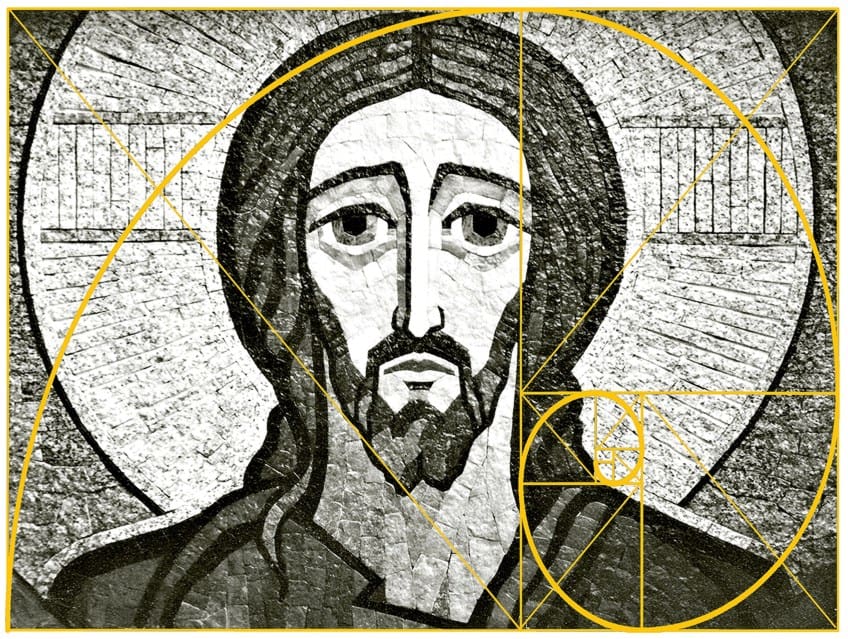
This appears to make the picture design more visually appealing and depends on the notion of the golden part being “perfect” once again. Pacioli was a mathematician from Italy who worked with Leonardo da Vinci and was a pioneer in the field of accounting.
He is known as the “Founder of Accounting” and he was the very first individual on the continent to produce a treatise on the double-entry system of bookkeeping.
Examples of the Fibonacci Sequence in Art
In art, the Fibonacci sequence is used because it is visually beautiful. It may be utilized to produce attractiveness, equilibrium, and harmony in design and art. Artists, architects, and mathematicians, employed this ratio in their work after discovering it in nature.
This secret formula was passed down over the generations to create what is thought to be the most harmonious interaction between visual components.
Something about it simply seems right. It’s a dynamic form—the brain tries, but can’t seem to map out this rectangle with basic numbers. This is because it is based on an irrational number. Let’s have a look at some specific examples of the Fibonacci sequence in art.
The School of Athens (c. 1511) by Raphael
| Artist | Raffaello Sanzio da Urbino (1483 – 1520) |
| Date Completed | c. 1511 |
| Medium | Oil painting |
| Location | Apostolic palace, Vatican City, Rome |
If there is any question that Raphael employed the Fibonacci spiral in the arrangement of this artwork, the golden rectangle that was put in the center of the picture should dispel it. Raphael made a brief but unmistakable gesture to respond to the question before it was posed.
This little rectangle is a unique characteristic. Perhaps it formerly bore the painting’s description.
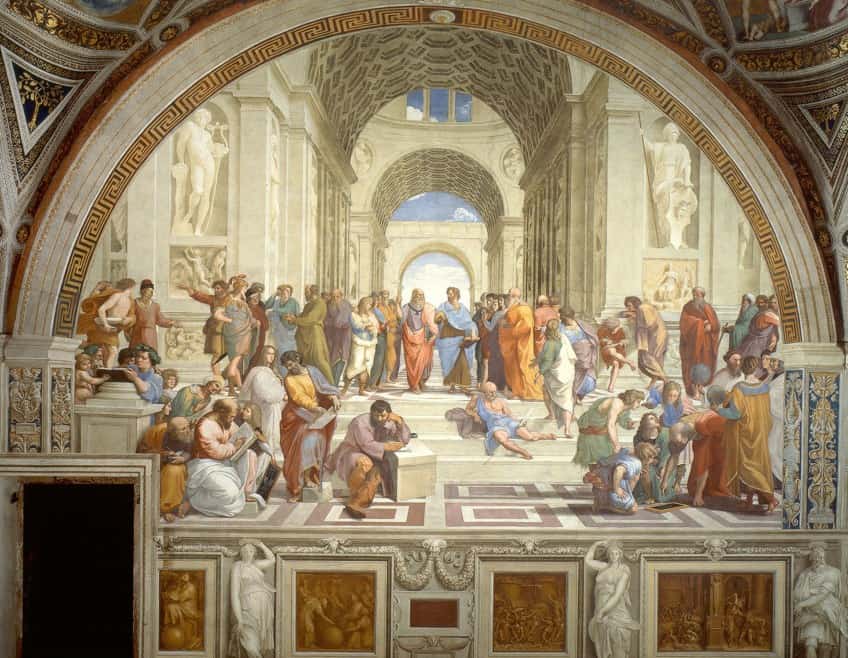
Even the framed area directly below it has a frame that is proportional to the borders on its sides in the Golden Ratio. In this composition, no other ratio would provide the same outcome. The picture has hundreds of detailed lines, so discovering Golden Ratios within it may appear to be a straightforward exercise in pattern recognition.
The Creation of Adam (1512) by Michelangelo
| Artist | Michelangelo di Lodovico Buonarroti Simoni (1475 – 1564) |
| Date Completed | 1512 |
| Medium | Fresco |
| Location | Sistine Chapel, Vatican City |
The Golden Ratio is reported to have been employed by Michelangelo in his painting of the Sistine Chapel. This Divine Proportion occurs at the point where God’s finger touches Adam’s finger as God breathes life into Adam. This discovery resulted in the identification of almost two dozen cases of the Golden Ratio.
This gives solid proof that the Divine proportion was a key guiding in the creation of this work.

Young Woman Reading in the Studio (1901) by David Oyens
| Artist | David Oyens |
| Date Completed | 1901 |
| Medium | Oil on canvas |
| Location | Mark Mitchell Paintings, Mayfair |
This is an excellent illustration of the Fibonacci spiral in the study of figures in interiors, whether occupied by labor or leisure, at which Oyens excelled. Their work has echoes of Chardin and Vermeer; here, the subject relates to Vermeer, with its side-lit chamber and woman reading, yet, it is also one in a long series of ladies depicted with a book.
The woman is so engrossed in her book that she has transformed into a passive component in the artwork along with the vase, easel, and painting box.
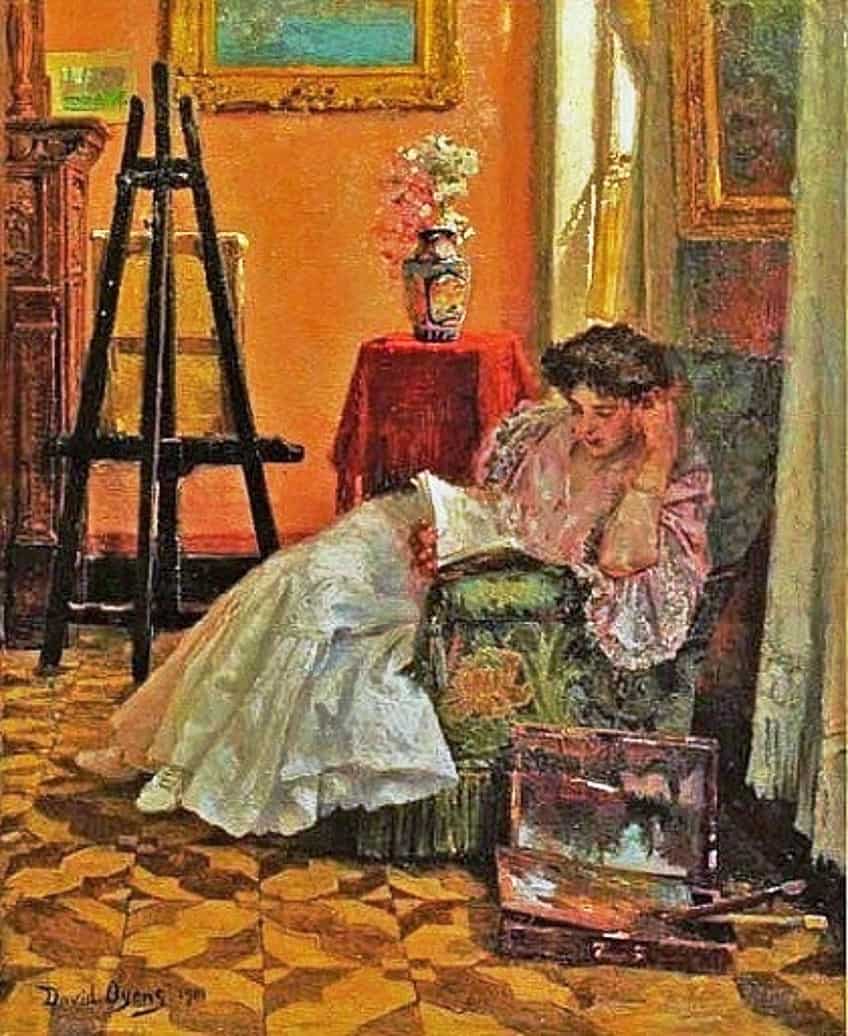
This enables the illumination to flow over the nearly abstract forms of her skirt sleeves, and her coloring towards becoming part of the overall harmony of the artwork. The Fibonacci spiral is apparent in the woman’s position here; the core point of the spiral is positioned on her eye, drawing attention to her serene occupation.
From here, it sweeps out to include the chair, the vertical window, and the slant of the easel in the backdrop, as well as the curvature of her shoulder and head with a line running along her forearm.
Tango Final of British Championship, Blackpool (1969) by Robert Greenham
| Artist | Robert Greenham (1906 – 1975) |
| Date Completed | 1969 |
| Medium | Oil on canvas |
| Location | Mark Mitchell Paintings, Mayfair |
This image is typical of Greenham’s social situations; it is also distinguished by his powerful outlines and sections of flat color. The dizzying perspective allows the dancing partners to be shown as a sequence of interconnecting stylized figures whirling up the canvas, black against the opalescent pastel colors of the dance frocks.
The curving strip between the foreground terrace ledge and the outside border of the brightly lit dancefloor creates the illusion of a complicated structured abstract pattern.
The impact of poster design from the 1930s through to the 1960s can be seen in many of his works. The overall composition is neatly delineated by two Fibonacci spirals, which follow the line of the spotlighted dance floor, the dresses and limbs of the dancers, and even the curvature of the center lady’s neck, and focus the attention on the two leading couples. The Fibonacci sequence is highly visible in this complicated, abstract painting, following the strong lines as it does, but it may also be observed in other, more realistic compositions.
Considering that mathematics is such a solemn and established discipline, it can be surprising to see the Fibonacci sequence used in artworks. Yet many architects and artists have utilized the Fibonacci theory successfully, yet often discreetly in their artworks. Whether this has actually had any effect, or if it’s more of a placebo for artists that allow them to feel that their works are more rooted in science and nature, is debatable. Yet, when so many renowned artists have explored the Fibonacci sequence in art, then perhaps there is something more to it worth exploring for yourself! You don’t have to stop there though, as there are creatives and intellectuals who apply the Fibonacci theory in their disciplines as well, such as musicians, architects, designers, scientists, and many more!
Take a look at our Fibonacci sequence webstory here!
Frequently Asked Questions
What Is the Fibonacci Sequence Used for in Art and Science?
The Fibonacci sequence may appear to have little to do with design but everything to do with science and mathematics. Isn’t everything simply numbers? In a few crucial ways, the sequence is related to design. The first thing that one should take note of is that the sequence is quite near the Golden Ratio. If you are unfamiliar with the Golden Ratio, then to put it in simple terms, the Golden Ratio is a design principle that has been used throughout history to generate aesthetically beautiful proportions in architecture, art, design, and even the human body. Second, the sequence occurs frequently in nature. This pattern and sequence may be found in tree branches, flowering artichokes, and leaf arrangement on a stalk, to mention a few examples. These random arrangements in nature are also thought to have a high aesthetic value for humans. Aside from these features, there is one important aspect of designing that the Fibonacci sequence may aid with. This is a principle that many designers completely disregard, regardless of their understanding of the sequence.
Exactly Why Is the Fibonacci Sequence So Important to the World?
Humans are built to see patterns, and when it comes to the Fibonacci numbers, we go beyond just seeking and praising nature’s sequence. Fibonacci and phi may be found in several works of architecture, art, and music. And, while purchasing and selling behavior is mostly unexpected, some financial experts claim to observe these figures at work there as well, notably during the present economic crisis. Technical analysts are investment experts that examine the historical forms of charts to assess if a current purchasing or selling trend will continue or reverse. Some forecasts utilize Fibonacci retracement levels drawn from the famous sequence. This is only one of the potential uses though, and the Fibonacci spiral can be utilized in many ways, including using the Fibonacci sequence in art. The Fibonacci sequence is also seen as Divinely significant and can be found in many religious works, especially the more modern spiritual practices and beliefs. It plays a large role in the theories of sacred geometry, as the ratio is said to bring about a state of equilibrium, peace, and harmony when utilized correctly.
Where Did the Fibonacci Sequence Originate?
Fibonacci was also known by the name Leonardo of Pisa. He initially proposed the Fibonacci sequence of numbers in his work Liver Abaci in 1202. Fibonacci was born into a wealthy Italian merchant family. As a member of a commercial family, mathematics was an essential component of the company. Fibonacci went around the Middle East and India, and the mathematical concepts he encountered intrigued him. Fibonacci’s book, Liver Abaci, was a lecture on the mathematical procedures in trading that he witnessed while traveling. While the series of numbers from this little brain teaser may appear insignificant, it has been rediscovered in an incredible variety of forms, from complex mathematics to applications in statistics, computer science, nature, and development.
Jordan Anthony is a Cape Town-based film photographer, curator, and arts writer. She holds a Bachelor of Art in Fine Arts from the University of the Witwatersrand, Johannesburg, where she explored themes like healing, identity, dreams, and intuitive creation in her Contemporary art practice. Jordan has collaborated with various local art institutions, including the KZNSA Gallery in Durban, the Turbine Art Fair, and the Wits Art Museum. Her photography focuses on abstract color manipulations, portraiture, candid shots, and urban landscapes. She’s intrigued by philosophy, memory, and esotericism, drawing inspiration from Surrealism, Fluxus, and ancient civilizations, as well as childhood influences and found objects. Jordan is working for artfilemagazine since 2022 and writes blog posts about art history and photography.
Learn more about Jordan Anthony and about us.
Cite this Article
Jordan, Anthony, “Fibonacci Sequence in Art – Using the Fibonacci Spiral in Art.” artfilemagazine – Your Online Art Source. November 18, 2022. URL: https://artfilemagazine.com/fibonacci-sequence-in-art/
Anthony, J. (2022, 18 November). Fibonacci Sequence in Art – Using the Fibonacci Spiral in Art. artfilemagazine – Your Online Art Source. https://artfilemagazine.com/fibonacci-sequence-in-art/
Anthony, Jordan. “Fibonacci Sequence in Art – Using the Fibonacci Spiral in Art.” artfilemagazine – Your Online Art Source, November 18, 2022. https://artfilemagazine.com/fibonacci-sequence-in-art/.


